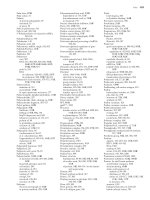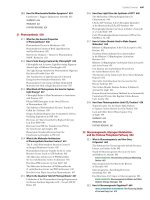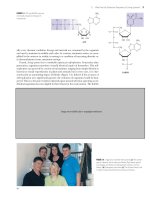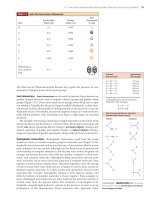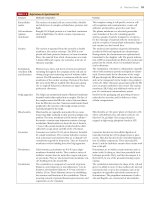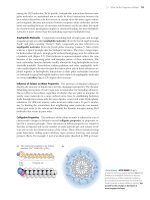Biochemistry, 4th Edition P105 pot
Bạn đang xem bản rút gọn của tài liệu. Xem và tải ngay bản đầy đủ của tài liệu tại đây (929.93 KB, 10 trang )
31.4 How Does Protein Degradation Regulate Cellular Levels of Specific Proteins? 1003
The pK
a
of Lys
526
is lowered in this complex, activating the lysine amino group for
nucleophilic attack to form the SUMO–target protein conjugate.
HtrA Proteases Also Function in Protein Quality Control
The discussion thus far has stressed the importance of protein quality control to cel-
lular health. HtrA proteases are a class of proteins involved in quality control that
combine the dual functions of chaperones and proteasomes. (The acronym Htr
comes from “high temperature requirement” because E. coli strains bearing muta-
tions in HtrA genes do not grow at elevated temperatures.) In addition to their novel
ability to be either chaperones or proteases, HtrA proteases are the only known pro-
tein quality control factor that is not ATP-dependent. Prokaryotic HtrA proteases act
as chaperones at low temperatures (20°C) where they have negligible protease ac-
tivity. However, as the temperature increases, these proteins switch from a chaperone
function to a protease function to remove misfolded or unfolded proteins from the
cell. With this functional duality, HtrA proteases have the potential to mediate qual-
ity control through protein triage (see A Deeper Look box on page 1004).
The E. coli HtrA protein DegP is the best characterized HtrA protease. DegP is lo-
calized in the E. coli periplasmic space, where it oversees quality control of proteins in-
(b)(a)
A
A
B
D
E
F
B
C
C
N
N
C
C
1
2
3
4
D
Leu
525
Lys
526
Ser
527
Glu
528
Lys
74
Thr
81
Asp
127
Cys
93
Glu
88
Ser
89
FIGURE 31.14 (a) The complex formed by the E2 enzyme, Ubc9 (yellow), and a target protein, RanGAP1 (blue).
(b) In the Ubc9–RanGAP1 complex, the exposed loop of RanGAP1 lies in the binding pocket of Ubc9.The
exposed loop contains the consensus sequence for sumoylation (ψKXD/E), including Leu
525
, which is sur-
rounded by hydrophobic residues from Ubc9; Lys
526
, which is coordinated by Asp
127
and Cys
93
of Ubc9; and
Glu
528
, which is coordinated by Ubc9 Thr
81
.
HUMAN BIOCHEMISTRY
Proteasome Inhibitors in Cancer Chemotherapy
Proteasome inhibition offers a promising approach to treating
cancer. The counterintuitive rationale goes like this: The protea-
some is responsible for the regulated destruction of proteins in-
volved in cell cycle progression and the control of apoptosis (pro-
grammed cell death). Inhibition of proteasome function leads to
cell cycle arrest and apoptosis. In clinical trials, proteasome in-
hibitors have retarded cancer progression by interfering with the
programmed degradation of regulatory proteins, causing cancer
cells to self-destruct. Bortezomib, a small-molecule proteasome in-
hibitor developed by Millenium Pharmaceuticals, Inc., has re-
ceived FDA approval for the treatment of multiple myeloma, a
cancer of plasma cells that accounts for 10% of all cancers of the
blood (see Figure 31.10a).
Source: Adams, J., 2003. The proteasome: Structure, function, and role in
the cell. Cancer Treatment Reviews Supplement 1:3–9.
1004 Chapter 31 Completing the Protein Life Cycle: Folding, Processing, and Degradation
volved in the cell envelope. It is a 448-residue protein containing a central protease
domain with a classic Ser protease Asp-His-Ser catalytic triad (see Chapter 14) and two
C-terminal PDZ domains. These domains are structural modules involved in protein–
protein interactions, and they recognize and bind selectively to the C-terminal three
or four residues of target proteins. Like other quality control systems, HtrA proteases
have a central cavity where proteolysis occurs (Figure 31.15); the height of this cavity
is 1.5 nm, which excludes folded proteins from access to the proteolytic sites. Thus,
HtrA proteases can act only on misfolded proteins. As we have seen, limited access to
proteolytic sites is an important regulatory feature of quality control proteases; only
(a)
90°
(b)
PDZ
PDZ
FIGURE 31.15 The HtrA protease structure. (a) A
trimer of DegP subunits represents the HtrA
functional unit.The different domains are color-
coded:The protease domain is green,PDZ do-
main 1 (PDZ1) is yellow, and PDZ domain 2
(PDZ2) is orange. Protease active sites are high-
lighted in blue.The trimer has somewhat of a
funnel shape, with the protease in the center
and the PDZ domains on the rim. (b) Two HtrA
trimers come together to form a hexameric
structure in which the two protease domains
form a rigid molecular cage (blue) and the six
PDZ domains are like tentacles (red) that both
bind protein substrate targets and control lateral
access into the protease cavity.
(Adapted from Fig-
ure 3 in Clausen,T., Southan, C., and Ehrmann, M., 2002.
The HtrA family of proteases: Implications for protein
composition and cell fate. Molecular Cell 10:443–455.)
A DEEPER LOOK
Protein Triage—A Model for Quality Control
Triage is a medical term for the sorting of patients according to
their need for (and their likelihood to benefit from) medical treat-
ment. Sue Wickner, Michael Maurizi, and Susan Gottesman have
pointed out that cells control the quality of their proteins through
a system of triage based on the chaperones and the ubiquitination-
proteasome degradation pathway. These systems recognize non-
native proteins (proteins that are only partially folded, misfolded,
incorrectly modified, damaged, or in an inappropriate compart-
ment). Depending on the severity of its damage, a non-native pro-
tein is directed to chaperones for refolding or targeted for de-
struction by a proteasome (see accompanying figure).
Adapted from Figures 2 and 3 in Wickner, S., Maurizi, M., and Gottesman,
S., 1999. Posttranslational quality control: Folding, refolding, and degrad-
ing proteins. Science 286:1888–1893.
ATP
Unfolded and misfolded
proteins
Ubiquitination
system
Ubiquitin and
Ubiquitinated
protein
Eukaryotic
chaperones
Bound
protein
Protein
remodeling
Native
protein
Protein bound
to proteasome
Degraded
p
rotein
ATP
ATP
Problems 1005
proteins targeted for destruction have access to such sites. The PDZ domains of the
HtrA proteases act as gatekeepers, determining access of protein substrates to the pro-
teolytic centers. Human HtrA proteases are implicated in stress response pathways.
Human HtrA1 is expressed at higher levels in osteoarthritis and aging and lower lev-
els in ovarian cancer and melanoma. Secreted human Htr1 may be involved in degra-
dation of extracellular matrix proteins involved in arthritis as well as tumor progres-
sion and invasion.
SUMMARY
31.1 How Do Newly Synthesized Proteins Fold? Most proteins fold
spontaneously, as anticipated by Anfinsen, whose experiments suggested
that all of the information necessary for a polypeptide chain to assume
its active, folded conformation resides in its amino acid sequence. How-
ever, some proteins depend on molecular chaperones to achieve their
folded conformation within the crowded intracellular environment.
Hsp70 chaperones are ATP-dependent proteins that bind to exposed
hydrophobic regions of polypeptides, preventing nonproductive associa-
tions with other proteins and keeping the protein in an unfolded state
until productive folding steps can take place. Hsp60 chaperones such as
GroEL–GroES are ATP-dependent cylindrical chaperonins that provide
a protected central cavity or “Anfinsen cage,” where partially folded pro-
teins can fold spontaneously, free from the danger of nonspecific hy-
drophobic interactions with other unfolded protein chains. Hsp90 chap-
erones assist a subset of “client proteins” involved in signal transduction
pathways in assuming their active conformations.
31.2 How Are Proteins Processed Following Translation? Nascent pro-
teins are seldom produced in their final, functional form. Maturation
typically involves proteolytic cleavage and may require post-translational
modification, such as phosphorylation, glycosylation, or other covalent
substitutions. Removal of nascent N-terminal methionine residues is a
common form of protein processing by proteolysis. The number of hu-
man proteins is believed to exceed the number of human genes (20,000
or so) by an order of magnitude or more. The great number of proteins
available from a fixed set of genes is attributed to a variety of processes,
including alternative splicing of mRNAs and post-translational modifica-
tion of proteins.
31.3 How Do Proteins Find Their Proper Place in the Cell? Most pro-
teins destined for compartments other than the cytosol are synthesized
with N-terminal signal sequences that target them to their proper desti-
nations. These signal sequences are recognized by signal recognition
particles as they emerge from translating ribosomes. The signal recog-
nition particle interacts with a membrane-bound signal receptor, deliv-
ering the translating
ribosome to a translocon, a multimeric integral
membrane protein structure having at its core the Sec61p complex. The
translocon transfers the growing protein chain across the membrane
(or in the case of nascent integral membrane proteins, inserts the pro-
tein into the membrane). Signal peptidases within the membrane com-
partment clip off the signal sequence. Other post-translational modifi-
cations may follow. Mitochondrial protein import and membrane
insertion are mediated by specific translocon complexes in the outer
mitochondrial membrane called TOM and SAM. Proteins destined for
the inner mitochondrial membrane or mitochondrial matrix must in-
teract with inner mitochondrial translocons (either TIM23 or TIM22)
as well as TOM.
31.4 How Does Protein Degradation Regulate Cellular Levels of Specific
Proteins? Protein degradation is potentially hazardous to cells, because
cell function depends on active proteins. Therefore, protein degradation
is compartmentalized in lysosomes or in proteasomes. Proteins targeted
for destruction are selected by ubiquitination. A set of three enzymes
(E
1
, E
2
, and E
3
) mediate transfer of ubiquitin to free ONH
2
groups in tar-
geted proteins. Proteins with charged or hydrophobic residues at their
N-termini are particularly susceptible to ubiquitination and destruction.
The ubiquitin moieties are recognized by 19S cap structures found at
either end of 26S proteasomes. Protein degradation occurs when, in an
ATP-dependent process, the ubiquitinated protein is unfolded and
threaded into the central cavity of the cylindrical ␣
7

7

7
␣
7
20S part of the
26S proteasome. The -subunits possess protease active sites that chop
the protein substrate into short (seven- to nine-residue) fragments; the
ubiquitin moieties are recycled. Linkage of SUMO (small ubiquitin-like
protein modifiers) to target proteins has the ability to alter their protein-
protein interactions. HtrA proteases also function in protein quality con-
trol. HtrA proteins are novel in two aspects: Unlike other chaperones and
proteasomes, they are ATP-independent; and unlike the others, they have
dual chaperone and protease activities and switch between these two
functions in response to stress conditions.
PROBLEMS
Preparing for an exam? Create your own study path for this
chapter at www.cengage.com/login.
1. (Integrates with Chapter 30.) Human rhodanese (33 kD) consists of
296 amino acid residues. Approximately how many ATP equivalents
are consumed in the synthesis of the rhodanese polypeptide chain
from its constituent amino acids and the folding of this chain into
an active tertiary structure?
2. A single proteolytic break in a polypeptide chain of a native protein
is often sufficient to initiate its total degradation. What does this
fact suggest to you regarding the structural consequences of proteo-
lytic nicks in proteins?
3. Protein molecules, like all molecules, can be characterized in terms of
general properties such as size, shape, charge, solubility/hydropho-
bicity. Consider the influence of each of these general features on the
likelihood of whether folding of a particular protein will require chap-
erone assistance or not. Be specific regarding just Hsp70 chaperones
or Hsp70 chaperones and Hsp60 chaperonins.
4. Many multidomain proteins apparently do not require chaperones
to attain the fully folded conformations. Suggest a rational scenario
for chaperone-independent folding of such proteins.
5. The GroEL ring has a 5-nm central cavity. Calculate the maximum
molecular weight for a spherical protein that can just fit in this cav-
ity, assuming the density of the protein is 1.25 g/mL.
6. (Integrates with Chapter 24.) Acetyl-CoA carboxylase has at least
seven possible phosphorylation sites (residues 23, 25, 29, 76, 77,
95, and 1200) in its 2345-residue polypeptide (see Figure 24.4).
How many different covalently modified forms of acetyl-CoA car-
boxylase protein are possible if there are seven phosphorylation
sites?
1006 Chapter 31 Completing the Protein Life Cycle: Folding, Processing, and Degradation
7. (Integrates with Chapter 30.) In what ways are the mechanisms of
action of EF-Tu/EF-Ts and DnaK/GrpE similar? What mechanistic
functions do the ribosome A-site and DnaJ have in common?
8. The amino acid sequence deduced from the nucleotide sequence of a
newly discovered human gene begins: MRSLLILVLCFLPLAALGK… .
Is this a signal sequence? If so, where does the signal peptidase act
on it? What can you surmise about the intended destination of this
protein?
9. Not only is the Sec61p translocon complex essential for transloca-
tion of proteins into the ER lumen, it also mediates the incorpora-
tion of integral membrane proteins into the ER membrane. The
mechanism for integration is triggered by stop-transfer signals that
cause a pause in translocation. Figure 31.5 shows the translocon as
a closed cylinder spanning the membrane. Suggest a mechanism
for lateral transfer of an integral membrane protein from the
protein-conducting channel of the translocon into the hydrophobic
phase of the ER membrane.
10. The Sec61p core complex of the translocon has a highly dynamic
pore whose internal diameter varies from 0.6 to 6 nm. In post-
translational translocation, folded proteins can move across the
ER membrane through this pore. What is the molecular weight
of a spherical protein that would just fit through a 6-nm pore?
(Adopt the same assumptions used in problem 5.)
11. (Integrates with Chapters 6, 9, and 30.) During co-translational
translocation, the peptide tunnel running from the peptidyl trans-
ferase center of the large ribosomal subunit and the protein-
conducting channel are aligned. If the tunnel through the ribosomal
subunit is 10 nm and the translocon channel has the same length as
the thickness of a phospholipid bilayer, what is the minimum number
of amino acid residues sequestered in this common conduit?
12. Draw the structure of the isopeptide bond formed between Gly
76
of
one ubiquitin molecule and Lys
48
of another ubiquitin molecule.
13. Assign the 20 amino acids to either of two groups based on their sus-
ceptibility to ubiquitin ligation by E
3
ubiquitin protein ligase. Can
you discern any common attributes among the amino acids in the
less susceptible versus the more susceptible group?
14. Lactacystin is a Streptomyces natural product that acts as an irre-
versible inhibitor of 26S proteasome -subunit catalytic activity by
covalent attachment to N-terminal threonine OOH groups. Predict
the effects of lactacystin on cell cycle progression.
15. HtrA proteases are dual-function chaperone-protease protein qual-
ity control systems. The protease activity of HtrA proteases depends
on a proper spatial relationship between the Asp-His-Ser catalytic
triad. Propose a mechanism for the temperature-induced switch of
HtrA proteases from chaperone function to protease function.
16. As described in this chapter, the most common post-translational
modifications of proteins are proteolysis, phosphorylation, methy-
lation, acetylation, and linkage with ubiquitin and SUMO pro-
teins. Carry out a Web search to identify at least eight other post-
translational modifications and the amino acid residues involved
in these modifications.
17. Fluorescence resonance energy transfer (FRET) is a spectroscopic
technique that can be used to provide certain details of the confor-
mation of biomolecules. Look up FRET on the Web or in an intro-
ductory text on FRET uses in biochemistry, and explain how FRET
could be used to observe conformational changes in proteins
bound to chaperonins such as GroEL. A good article on FRET in
protein folding and dynamics can be found here: Haas, E., 2005.
The study of protein folding and dynamics by determination of in-
tramolecular distance distributions and their fluctuations using en-
semble and single-molecule FRET measurements. ChemPhysChem
6:858–870. Studies of GroEL using FRET analysis include the fol-
lowing: Sharma, S., et al., 2008. Monitoring protein conformation
along the pathway of chaperonin-assisted folding. Cell 133:142–153;
and Lin, Z., et al., 2008. GroEL stimulates protein folding through
forced unfolding. Nature Structural and Molecular Biology 15:303–311.
18. The cross-talk between phosphorylation and ubiquitination in pro-
tein degradation processes is encapsulated in the concept of the
“phosphodegron.” What is a phosphode
gron, and how does phos-
phorylation serve as a recognition signal for protein degradation?
(A good reference on the phosphodegron and crosstalk between
phosphorylation and ubiquitination is Hunter, T., 2007. The age of
crosstalk: Phosphorylation, ubiquitination, and beyond. Molecular
Cell 28:730–738.)
Preparing for the MCAT Exam
19. A common post-translational modification is removal of the univer-
sal N-terminal methionine in many proteins by Met-aminopeptidase.
How might Met removal affect the half-life of the protein?
20. Figure 31.6 shows the generalized amphipathic ␣-helix structure
found as an N-terminal presequence on a nuclear-encoded mito-
chondrial protein. Write out a 20-residue-long amino acid sequence
that would give rise to such an amphipathic ␣-helical secondary
structure.
FURTHER READING
Protein-Folding Diseases
Bates, G., 2003. Huntingdin aggregation and toxicity in Huntington’s
disease. Lancet 361:1642–1644.
Bucciantini, M., Giannoni, E., et al., 2002. Inherent toxicity of aggre-
gates implies a common mechanism for protein misfolding. Nature
416:507–511.
Gamblin, T. C., Chen, F., et al., 2003. Caspase cleavage of tau: Linking
amyloid and neurofibrillary tangles in Alzheimer’s disease. Proceed-
ings of the National Academy of Sciences U.S.A. 100:10032–10037.
Herczenik, E., and Gebbink, M. F., 2008. Molecular and cellular aspects
of protein misfolding and disease. FASEB Journal 22:2115–2133.
Soto, C., Estrada, L., et al., 2006. Amyloids, prions, and the inherent in-
fectious nature of misfolded protein aggregates. Trends in Biochemi-
cal Sciences 31:150–156.
Winklhofer, K. F., Tatzelt, J., et al., 2008. The two faces of protein mis-
folding: Gain- and loss-of-function in neurodegenerative diseases.
EMBO Journal 27:336–349.
Chaperone-Assisted Protein Folding
Bigotti, M. G., and Clarke, A. R., 2008. Chaperonins: The hunt for the
group II mechanism. Archives of Biochemistry and Biophysics 474:
331–339.
Bukau, B., et al., 2000. Getting newly synthesized proteins into shape.
Cell 101:119–122.
Bukau, B., Weissman, J., et al., 2006. Molecular chaperones and protein
quality control. Cell 125:443–451.
Ellis, J. R., 2001. Molecular chaperones: Inside and outside the Anfinsen
cage. Current Biology 11:R1038–R1040.
Frydman, J., 2001. Folding of newly translated proteins in vivo: The role
of molecular chaperones. Annual Review of Biochemistry 70:603–647.
Hartl, F. U., and Hayer-Hartl, H., 2002. Molecular chaperones in the
cytosol: From nascent chain to folded chain. Science 295:1852–1858.
Jahn, T., and Radford, S. E., 2007. Folding versus aggregation: Polypep-
tide conformations on competing pathways. Archives of Biochemistry
and Biophysics 469:100–117.
Further Reading 1007
Kramer, G., et al., 2002. L23 protein functions as a chaperone docking
site on the ribosome. Nature 419:171–174.
Lin, Z., Madan, D., et al., 2008. GroEL stimulates protein folding
through forced unfolding. Nature Structural and Molecular Biology
15:303–311.
Luheshi, L. M., Crowther, D. C., et al., 2008. Protein misfolding and dis-
ease: From the test tube to the organism. Current Opinion in Chemi-
cal Biology 12:25–31.
Sharma, S., Chakraborty, K., et al., 2008. Monitoring protein conformation
along the pathway of chaperonin-assisted folding. Cell 133:142–153.
Vogel, M., Bukau, B., et al., 2006. Allosteric regulation of Hsp70 chap-
erones by a proline switch. Molecular Cell 21:359–367.
Protein Translocation
Bolender, N., Sickmann, A., et al., 2008. Multiple pathways for sorting
mitochondrial precursor proteins. EMBO Reports 9:42–49.
Bornemann, T., Jockel, J., et al., 2008. Signal sequence-independent
membrane targeting of ribosomes containing short nascent pep-
tides within the exit tunnel. Nature Structural and Molecular Biology
15:494–499.
Brodersen, D. E., and Nissen, P., 2005. The social life of ribosomal pro-
teins. FEBS Journal 272:2098–2108.
Kutik, S., Guiard, B., et al., 2007. Cooperation of translocase complexes
in mitochondrial protein import. Journal of Cell Biology 179:585–591.
Mihara, K., 2003. Moving inside membranes. Nature 424:505–506.
Rapoport, T. A., 2007. Protein translocation across the eukaryotic en-
doplasmic reticulum and bacterial plasma membranes. Nature
450:663–669.
Schnell, D. J., and Hebert, D. N., 2003. Protein translocons: Multi-
functional mediators of protein translocation across membranes.
Cell 112:491–505.
Schwartz, S., and Blobel, G., 2003. Structural basis for the function of
the -subunit of the eukaryotic signal recognition particle.
Cell 112:
793–803.
Skach, W., 2007. The expanding role of the ER translocon in membrane
protein folding. Journal of Cell Biology 179:1333–1335.
Wirth, A., et al., 2003. The Sec61p complex is a dynamic precursor acti-
vated channel. Molecular Cell 12:261–268.
Ubiquitin Selection of Proteins for Degradation
Bellare, P., Small, E. C., et al., 2008. A role for ubiquitin in the spliceosome
assembly pathway. Nature Structural and Molecular Biology 15:444–451.
Hershko, A., 1996. Lessons from the discovery of ubiquitin system.
Trends in Biochemical Sciences 21:445–449.
Hochstrasser, M., 1996. Ubiquitin-dependent protein degradation. An-
nual Review of Genetics 30:405–439.
Hunter, T., 2007. The age of crosstalk: Phosphorylation, ubiquitination,
and beyond. Molecular Cell 28:730–738.
Madsen, L., Schulze, A., et al., 2007. Ubiquitin domain proteins in dis-
ease. BMC Biochemistry 8:
1–8.
V
arshvsky, A., 1997. The ubiquitin system. Trends in Biochemical Sciences
22:383–387.
Proteasome-Mediated Protein Degradation
Borissenko, L., and Groll, M., 2007. 20S proteasome and its inhibitors:
Crystallographic knowledge for drug development. Chemical Reviews
107:687–717.
Breusing, N., and Grune, T., 2008. Regulation of proteasome-mediated
protein degradation during oxidative stress and aging. Biological
Chemistry 389:203–209.
Dahlmann, B., 2007. Role of proteasomes in disease. BMC Biochemistry
8:1–12.
Ferrel, K., et al., 2000. Regulatory subunit interactions of the 26S pro-
teasome, a complex problem. Trends in Biochemical Sciences 25:83–88.
Groll, M., Berkers, C. R., et al., 2006. Crystal structure of the boronic
acid-based proteasome inhibitor bortezomib in complex with the
yeast 20S proteasome. Structure 14:451–456.
Zhang, F., Paterson, A. J., et al., 2007. Metabolic control of proteasome
function. Physiology 22:373–379.
HtrA Proteases
Clausen, T., Southan, C., et al., 2002. The HtrA family of proteases: Im-
plications for protein composition and cell fate. Molecular Cell
10:443–455.
Kim, D. Y., and Kim, K. K., 2005. Structure and function of HtrA family
proteins, the key players in protein quality control. Journal of Bio-
chemistry and Molecular Biology 38:266–274.
Sohn, J., Grant, R. A., et al., 2007. Allosteric activation of DegS, a stress
sensor PDZ protease. Cell 131:572–583.
Walle, L. V., Lamkanfi, M., et al., 2008. The mitochondrial serine pro-
tease HtrA2/Omi: An overview. Cell Death and Differentiation 15:
453–460.
Post-translational Modification by Sumoylation
Anckar, J., and Sistonen, L., 2007. SUMO: Getting it on. Biochemical So-
ciety Transactions 35:1409–1413.
Bernier-Villamor, V., Sampson, D. A., et al., 2002. Structural basis for
E2-mediated SUMO conjugation revealed by a complex between
ubiquitin-conjugating enzyme Ubc9 and RanGAP1. Cell 108:345–356.
Geiss-Friedlander, R., and Melchior, F., 2007. Concepts in sumoylation:
A decade on. Nature Reviews Molecular Cell Biology 8:947–956.
Hay, R. T., 2005. SUMO: A history of modification. Molecular Cell
18:1–12.
Johnson, E. S., 2004. Protein modification by SUMO. Annual Review of
Biochemistry 73:355–382.
Ulrich, H. D., 2005. Mutual interactions between the SUMO and ubiq-
uitin systems: A plea of no contest. Trends in Cell Biology 15:525–532.
Vertegaal, A. C. O., 2007. Small ubiquitin-related modifiers in chains.
Biochemical Society Transactions 35:1422–1423.
Yunus, A. A., and Lima, D. D., 2006. Lysine activation and functional
analysis of E2-mediated conjugation in the SUMO pathway. Nature
Structural and Molecular Biology 13:491–499.
Florentine Royal Collection, Windsor, England A.K.G.,
Berlin/Superstock, International
32
The Reception
and Transmission
of Extracellular Information
Hormones are secreted by certain cells, usually located in glands, and travel, either
by simple diffusion or circulation in the bloodstream, to specific target cells (Fig-
ure 32.1). As we shall see, some hormones bind to specialized receptors on the
plasma membrane and induce responses within the cell without themselves enter-
ing the target cell (Figure 32.2). Other hormones actually enter the target cell and
interact with specific receptors there. By these mechanisms, hormones:
•Regulate the metabolic processes of various organs and tissues
• Facilitate and control growth, differentiation, reproductive activities, learning,
and memory
• Help the organism cope with changing conditions and stresses in its environment
All these effects of hormonal signals are either metabolic responses or gene expression
responses (Figure 32.2).
32.1 What Are Hormones?
Many different chemical species act as hormones. Steroid hormones, all derived from
cholesterol, regulate metabolism, salt and water balances, inflammatory processes,
and sexual function. Several hormones are amino acid derivatives. Among these are
epinephrine and norepinephrine (which regulate smooth muscle contraction and relax-
ation, blood pressure, cardiac rate, and the processes of lipolysis and glycogenolysis)
and the thyroid hormones (which stimulate metabolism). Peptide hormones are a large
group of hormones that regulate processes in all body tissues, including the release
of yet other hormones.
Hormones and other signal molecules in biological systems bind with very high
affinities to their receptors, displaying K
D
values in the range of 10
Ϫ12
to 10
Ϫ6
M. The
hormones are produced at concentrations equivalent to or slightly above these K
D
values. Once hormonal effects have been induced, the hormone is usually rapidly
metabolized.
Steroid Hormones Act in Two Ways
The steroid hormones include the glucocorticoids (cortisol and corticosterone), the
mineralocorticoids (aldosterone), and the sex hormones (progesterone and testos-
terone, for example) (Figure 32.1; see Chapter 24 for the details of their synthesis).
The steroid hormones exert their effects in two ways: First, by entering cells and mi-
Drawing of a human fetus in utero, by Leonardo da
Vinci. Human sexuality and embryonic development
represent two hormonally regulated processes of uni-
versal interest.
“How little we know, how much to discover,
What chemical forces flow from lover to lover.
How little we understand what touches off that
tingle,
That sudden explosion when two tingles
intermingle.
Who cares to define what chemistry this is?
Who cares with your lips on mine
How ignorant bliss is,
So long as you kiss me and the world around us
shatters?
How little it matters how little we know”
“How Little We Know”
by P. Springer and C. Leigh
(Excerpt from “How Little We Know” by P. Springer
and C. Leigh as recorded by Frank Sinatra,
April 5, 1956. Capitol Records, Inc.)
KEY QUESTIONS
32.1 What Are Hormones?
32.2 What Is Signal Transduction?
32.3 How Do Signal-Transducing Receptors
Respond to the Hormonal Message?
32.4 How Are Receptor Signals Transduced?
32.5 How Do Effectors Convert the Signals
to Actions in the Cell?
32.6 How Are Signaling Pathways Organized
and Integrated?
32.7 How Do Neurotransmission Pathways
Control the Function of Sensory Systems?
ESSENTIAL QUESTION
Higher life forms must have molecular mechanisms for detecting environmental infor-
mation as well as mechanisms that allow for communication at the cell and tissue lev-
els. Sensory systems detect and integrate physical and chemical information from the
environment and pass this information along by the process of neurotransmission.
Control and coordination of processes at the cell and tissue levels are achieved not
only by neurotransmission but also by chemical signals in the form of hormones that
are secreted by one set of cells to direct the activity of other cells.
What are these mechanisms of information transfer that mediate the molecular
basis of hormone action and that use excitable membranes to transduce the
signals of neurotransmission and sensory systems?
Create your own study path for
this chapter with tutorials, simulations, animations,
and Active Figures at www.cengage.com/login.
32.1 What Are Hormones? 1009
grating to the nucleus, steroid hormones act as transcription regulators, modulating
gene expression. These effects of the steroid hormones occur on time scales of hours
and involve synthesis of new proteins. Steroids can also act at the cell membrane, di-
rectly regulating ligand-gated ion channels and perhaps other processes. These latter
processes take place very rapidly, on time scales of seconds and minutes.
Somatostatin
(anterior
pituitary)
Testosterone
Estradiol
(many: vascular system,
reproductive organs,
central nervous system,
gastrointestinal tract,
immune system, skin,
kidney, and lung)
Bradykinin
(blood vessels)
Prolactin
(breast)
Glucagon
(primarily liver)
Gastrin
(GI tract, gall
bladder, pancreas)
Luteinizing
hormone (LH)
(gonads, ovarian
follicle cells)
Follicle-stimulating
hormone (FSH)
(gonads)
Adrenocorticotropic
hormone (ACTH)
(adrenal cortex)
Insulin (primarily
liver, muscle, fat)
Growth hormone
(GH) (many:
bone, fat, liver)
Chorionic
gonadotropin
(various
reproductive
tissues)
Calcitonin
(bone)
FIGURE 32.1 The sites of synthesis and action of a few
of the polypeptide and steroid hormones. Hormones
typically circulate at low concentrations (1 nM or less)
and bind with high affinity to their receptor proteins.
Nonsteroid
hormone
Steroid
hormone
Gene expression
Transcription responses
Signal transduction
pathways
Nucleus
Metabolic responses
FIGURE 32.2 Nonsteroid hormones bind exclusively to
plasma membrane receptors, which mediate the cellular
responses to the hormone. Steroid hormones exert their
effects either by binding to plasma membrane recep-
tors or by diffusing to the nucleus, where they modulate
transcriptional events. Intracellular responses to hor-
mone binding include metabolic changes and alter-
ations of gene expression.
1010 Chapter 32 The Reception and Transmission of Extracellular Information
Polypeptide Hormones Share Similarities of Synthesis and Processing
The largest class of hormones in vertebrate organisms is that of the polypeptide
hormones (Figure 32.1). One of the first polypeptide hormones to be discovered,
insulin, was described by Banting and Best in 1921. Insulin, a secretion of the pan-
creas, controls glucose utilization and promotes the synthesis of proteins, fatty acids,
and glycogen. Insulin, which is typical of the secreted polypeptide hormones, is dis-
cussed in detail in Chapters 5, 15, and 22.
Many other polypeptide hormones are produced and processed in a manner sim-
ilar to that of insulin. Three unifying features of their synthesis and cellular process-
ing should be noted. First, all secreted polypeptide hormones are originally synthe-
sized with a signal sequence, which facilitates their eventual direction to secretory
granules, and thence to the extracellular milieu. Second, peptide hormones are usu-
ally synthesized from mRNA as inactive precursors, termed preprohormones, which
become activated by proteolysis. Third, a single polypeptide precursor or prepro-
hormone may produce several different peptide hormones by suitable proteolytic
processing.
An impressive example of the production of many hormone products from a
single precursor is the case of prepro-opiomelanocortin, a 250-residue precursor
peptide synthesized in the pituitary gland. A cascade of proteolytic steps produces,
as the name implies, a natural opiate substance (endorphin) and several other hor-
mones (Figure 32.3). Endorphins and other opiatelike hormones are produced by
the body in response to systemic stress. These substances probably contribute to the
“runner’s high” that marathon runners describe.
32.2 What Is Signal Transduction?
Hormonal regulation depends on the transduction of the hormonal signal across
the plasma membrane to specific intracellular sites, particularly the nucleus. Signal
transduction consists of a stepwise progression of signaling stages: receptor⎯→
transducers⎯→effectors. The receptor perceives the signal, transducers relay the
signal, and the effectors convert the signal into an intracellular response.
What are the characteristics of signal transduction systems? Regardless of the
organism or the tissue, certain features appear to be universal, or nearly so:
• Transmembrane communication of hormonal signals by receptor proteins
• Protein interaction domains that selectively recognize specific structural motifs
and bind them with high affinity and specificity
Signal
peptide
Signal
peptidase
26 48 12 14
Corticotropin
Anterior
pituitary
Nervous
tissue
-Lipotropin
-MSH␣-MSH Endorphin
18 312140 40
Pro-opiomelanocortin
Prepro-opiomelanocortin
␥-Lipotropin
FIGURE 32.3 The conversion of prepro-opiomelanocortin to a family of peptide hormones, including
corticotropin, - and ␥-lipotropin, ␣- and -MSH, and endorphin.
32.2 What Is Signal Transduction? 1011
• Clustering of membrane receptors and their ligands in large aggregates called
signalsomes
• Reversible covalent modifications that change the function of certain proteins
and lipids (including phosphorylation, methylation, acetylation, ubiquitylation,
hydroxylation, and cleavage)
• Second messengers that bind to specific targets, changing their activity and be-
havior
• Intracellular signaling pathways, often involving a series of enzymes (such as pro-
tein kinases), that link receptors to their downstream functional targets
• Cooperativity
• Spatial and temporal control of signals and messengers
• Integration of signals
• Converging and diverging networks
•Signal amplification
• Desensitization and adaptation
Many Signaling Pathways Involve Enzyme Cascades
Signaling pathways must operate with speed and precision, facilitating the accurate
relay of intracellular signals to specific targets. But how does this happen? Enzyme
cascades are one answer to this question. Enzymes can produce (or modify) a large
number of molecules rapidly and specifically. Many enzymes of signaling cascades
are protein kinases and protein phosphatases, and many steps in signaling pathways
involve phosphorylation of serine, threonine, and tyrosine residues on target pro-
teins. The complexity of signal transduction is thus manifested in the estimates that
the human genome contains about a thousand protein kinase and protein phos-
phatase genes. Enzyme cascades act like a series of amplifiers, dramatically increas-
ing the magnitude of the intracellular response available from a very small amount
of hormone.
Signaling Pathways Connect Membrane Interactions with Events
in the Nucleus
The complete pathway from hormone binding at the plasma membrane to modula-
tion of transcription in the nucleus is understood for a few signaling pathways. Figure
32.4 shows a complete signal transduction pathway that connects receptor tyrosine
kinases, the Ras GTPase, cytoplasmic Raf, and two other protein kinases with tran-
scription factors that alter gene expression in the nucleus. This pathway represents
just one component of a complex signaling network that involves many other proteins
and signaling factors. The existence of nearly 4000 human genes devoted to signal
transduction portends a complex and interwoven network of signaling interactions in
nearly all human cells.
1
Signaling Pathways Depend on Multiple Molecular Interactions
Each step in a signaling pathway depends on one or more molecular interac-
tions. For example, a protein may bind to a small molecule, a peptide, or even
another protein (Figure 32.5). In fact, many signaling proteins are constructed
in a cassettelike fashion with several distinct modules, termed protein interaction
domains (PIDs), each of which mediates a particular interaction (Figure 32.6a).
A protein with multiple modules can interact with several binding targets at once
to create a complex, called a signalsome, with multiple signaling capabilities
(Figure 32.6b). Several signaling systems described in this chapter involve events
at a signalsome.
1
The American Association for the Advancement of Science oversees a consortium of researchers who
have established a Web site—the Signal Transduction Knowledge Environment (STKE). This site is an
up-to-date and ongoing compilation of information about cell signaling and signal transduction. The
URL is .
1012 Chapter 32 The Reception and Transmission of Extracellular Information
GTP GDP
Active
Raf
Raf
P
MAPKK
Active
MAPKK
2
2
P
Polypeptide
hormone
MAPK
Thr
Active
MAPK
P
MAPK kinase
Mitogen-activated protein kinase
Tyrosine
kinase
Tyr
Tyr
Ras
Ras
GRB2
SOS
Receptor tyrosine kinase(RTK)
Nucleus
Fos
ATF-2
Jun
Myc
Gene transcription
Protein synthesis
Transcription
factor
phosphorylation
Tyr
P
ATP ADP
ATP ADP
ACTIVE FIGURE 32.4 A complete signal transduction pathway that connects a hormone
receptor with transcription events in the nucleus. A number of similar pathways have been characterized.
Test yourself on the concepts in this figure at www.cengage.com/login.
